Blog / 2023 / Mistake #5: Blaming Myself for Being Too Nice
May 11, 2023
This month, my art career officially turns twenty. To celebrate this special artiversary, I’m doing a blog series about everyday errors, because, if I had to choose one reason why I’m still making art after all this time, it’s that I refused to let these little missteps stop me.
So far, I’ve written about being sensitive, resisting change, publishing so-so work, and copying others. Today’s installment of the Goof-up Gala has to do with how an artist forms professional relationships with art critics and others who have power over their career.
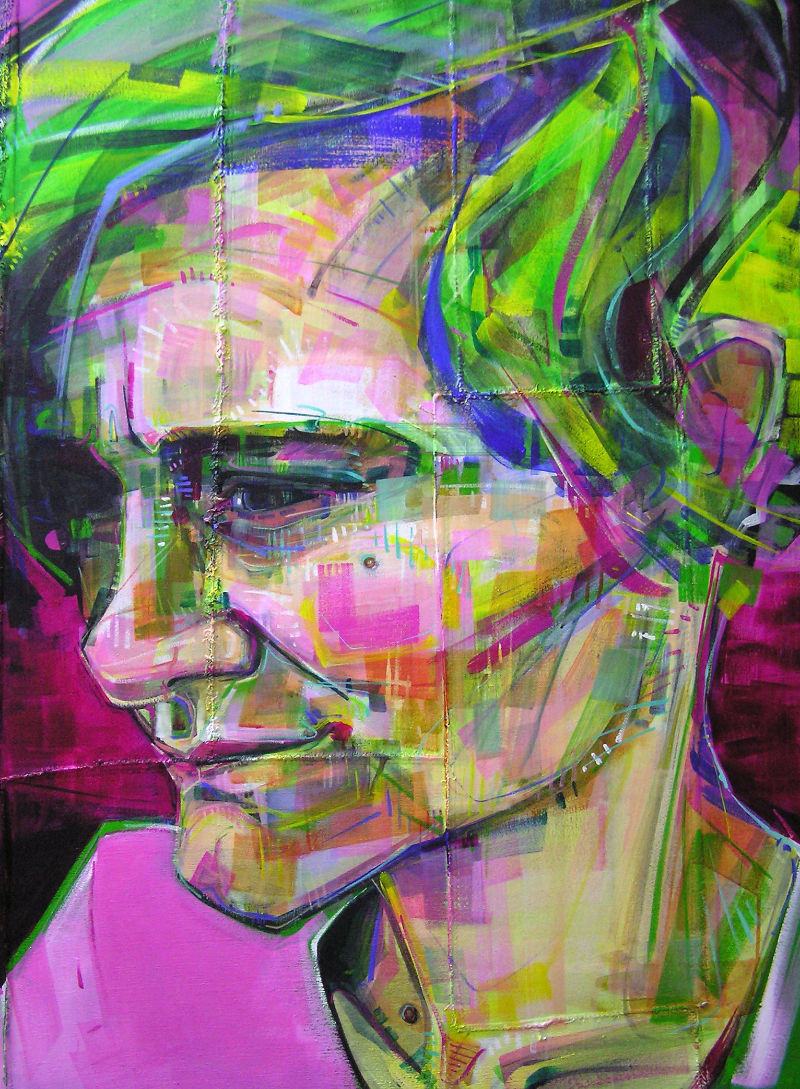
Self-portrait
2005
acrylic on canvas patchwork
48 x 34 inches
Press is never easy to digest. Reading a review of your work feels a little like getting graded in school, except that what’s being evaluated isn’t some research paper on a subject you never really cared about. Instead, it’s your blood, sweat, and tears. It’s a little piece of you that you’ve broken off and sent out into the world. And now someone is telling everybody else whether or not that piece of you is worthwhile.
I’ve had my share of poor grades over the years, but of all the unflattering ink that’s been spilled over my art, one particular article stands out. In it, The Critic of my city—the guy who was, at the time, the voice of the local art world—vented his frustration about his unrequited attraction to me.
The story starts in 2005 when I contacted The Critic, not with a press release about an upcoming show, but with a comment about one of his articles. My approach was cheeky. I was trying to stand out among all the emails he was almost certainly receiving from artists looking for attention. We struck up an email conversation, and, before long, The Critic suggested that we continue our chat at my studio.
This was the stuff of legends in my young painter’s mind. It was the sort of thing that happened to artists in history books. I’d just turned 24, and, by that point, I’d been making a meager but steady living with my art for three years, which is no mean feat. Still, The Critic’s interest in seeing work that wasn’t on exhibit felt Next Level.
And it was! But not how I thought it would be. The reality of his visit was far lovelier than I expected. I not only shared my art with someone who had an unusual and important stake in the local scene, but I also got to know The Critic as a person. Our rambling exchange covered where he was coming from in terms of both his taste and his values, and we also talked about what made me the person I was.
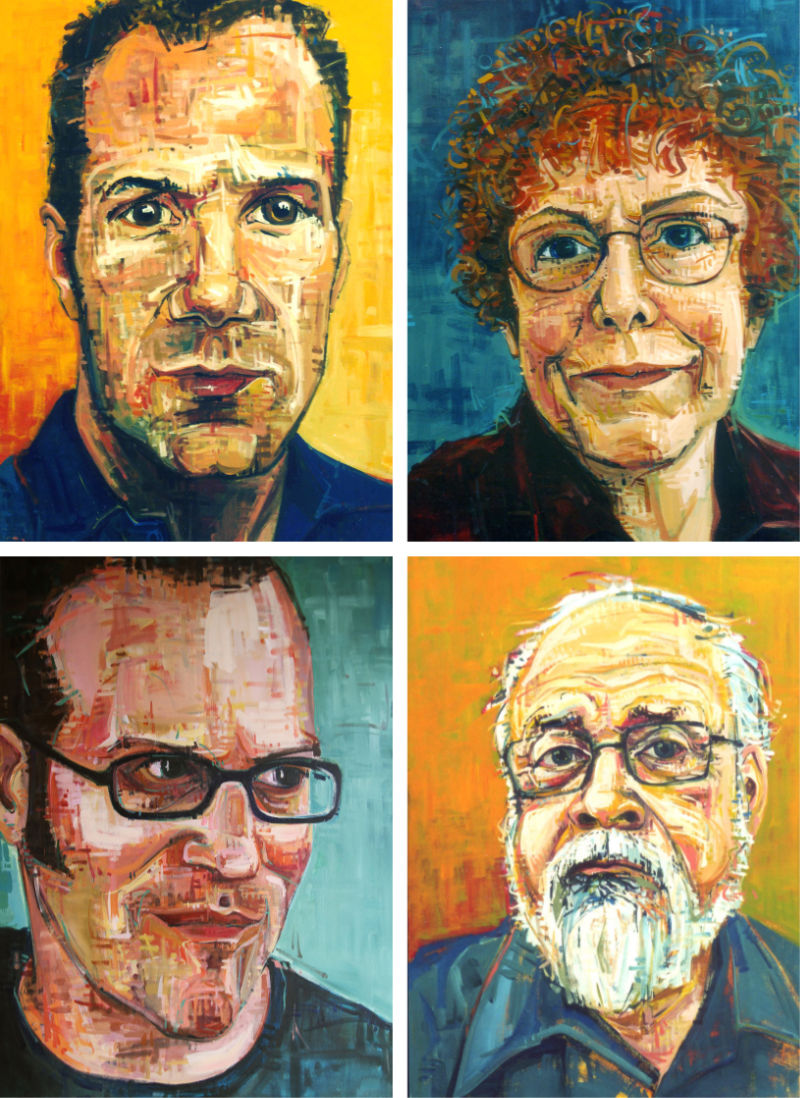
I ended up telling him about my obsession with power dynamics, a fascination I’d acquired early. My first recorded dissatisfaction with the patriarchy came at five years old, when I learned that there’d never been a female president of the US. And my disappointment with our society rapidly grew from there, with my years of Catholic school fueling my desire to end The Rule of Men. By the time I turned 24, I had a lifetime of experience poking at authority figures, male and female alike. I was done deferring to people simply because they had a job title I was supposed to respect. I cherished every individual’s humanity, but chose only to bestow extra regard when a person earned it.
To wit, my first professional body of work was a series of portraits of local gallery owners painted in 2003. Critics Critiqued was an obvious example of me using portraiture to reverse traditional power dynamics, forcing gatekeepers to evaluate my work while also making sure they couldn’t pretend they were impartial about it.
In a sense, my conversations with The Critic—both in my studio and, later, as we kept writing each other—were a continuation of this concept. I’d started off our relationship with irreverence and he’d responded playfully, so I never felt like I had to dull who I was for him. Considering the power he had over me, I was impressed with how opposite-of-gross The Critic was being.
In retrospect, it’s clear that’s where my problems began.
Fast forward a few months, and my mobile started buzzing in my pocket. The Critic was calling me while I was at an art event with David, my partner. At the time, David and I had only just met—our first kiss had happened a week prior—but I was already pretty sure that he was my forever person. I checked my phone and then looked up to see The Critic making his way towards us through the crowd. I introduced David to the newspaperman, and some clumsy dialogue followed. When my sweetie excused himself to get us drinks, The Critic suddenly shifted gears:
“You’re quite the heartbreaker.”
Since there seemed like only one way to interpret his statement and since I’d never been interested in The Critic romantically, I said a quick goodbye and went to find David.
The exchange unsettled me, but, over the next few months, the budding friendship with the art reviewer continued. He went out of his way to give me pep talks when the closed-mindedness of the art world got me down. The Critic advised me about the local scene, giving me insight into the different players and telling me which galleries he thought my art might fit best in.
Back when we’d first met, I’d asked him to let me do his portrait and he’d agreed. But, in late 2005, when it came time for me to actually photograph and interview him for the portrait, he backed out. He told me that, if I painted him, he wouldn’t be able to write about me for The Paper, because no one would take his writing seriously. I told him I didn’t care, that I would rather be his friend.
“That’s refreshing,” The Critic said, but he still declined to have his portrait painted.
I started sending the art reviewer funny little drawings of the two of us on fantastical art adventures, cartoon snapshots of The Critic and The Artist as friends—as if that were actually possible. Then, in early 2006, I unstretched a self-portrait I’d painted on canvas, folded it up into an envelope, and used it to mail The Critic a press release.
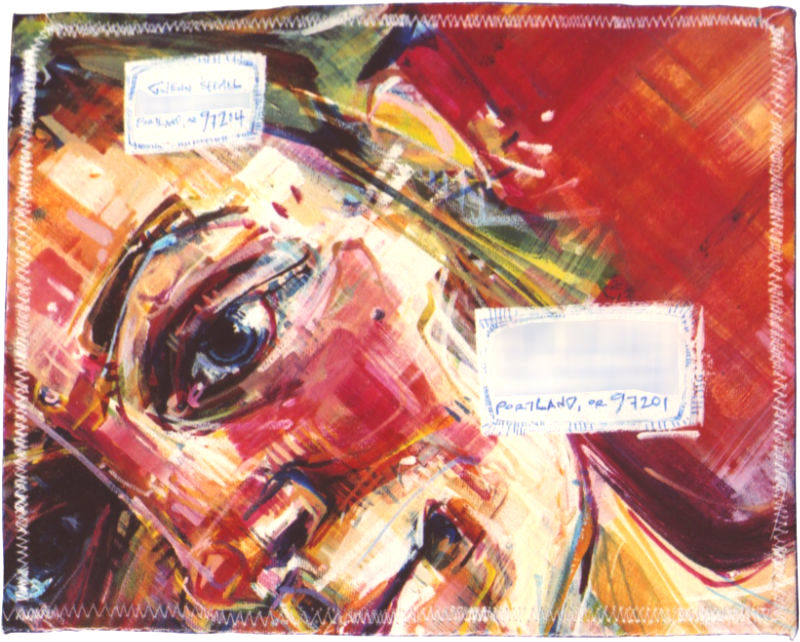
Artist as Press Package
2006
acrylic on canvas, sewn into an envelope
12 x 15 inches
The gesture was big. I was, after all, ruining one of my paintings in order to make it into the envelope shown above. (The addresses in the pic are blurred for privacy.)
Still, I saw this less as an act of destruction and more as upcycling the original piece into a new artwork. The portrait-envelope became a tongue-in-cheek statement about the artist as a tool for marketing their own art, an acknowledgment that an experience of my art couldn’t be separate from an experience of me. Plus, I had way too many unsold paintings in my studio to be precious about my work.
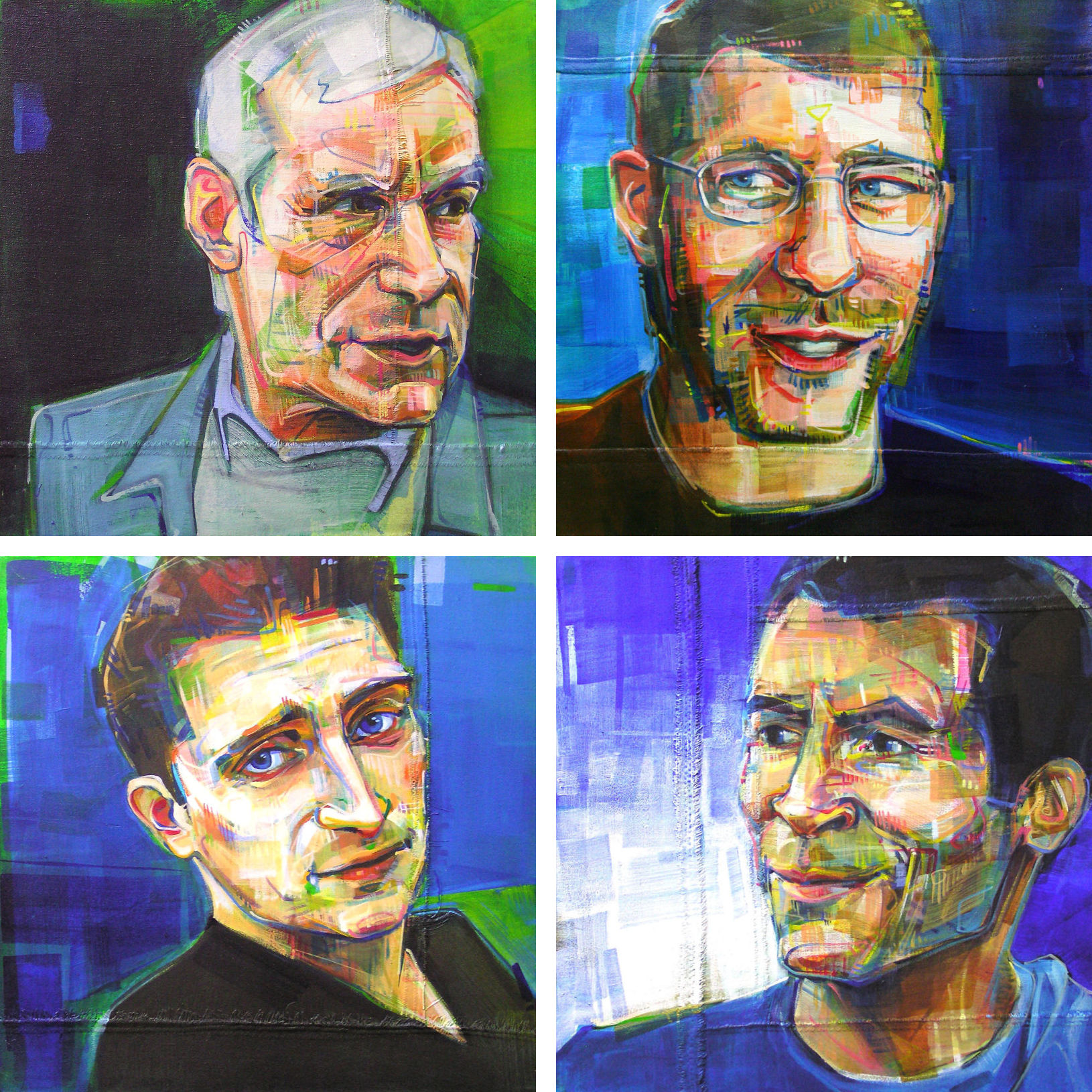
The press release was for a show called Mutually Beneficial, which consists of portraits of men I’d met online through their personal ads on the “men seeking women” section of Craig’s List.
The men had been chosen carefully. In their ads, each one specified that they met the heteronormative standard of male-as-provider, though they ran the gamut from the innocuous types who noted they had a job to the ones who veered closer to qualifying as aspiring sugar daddies. The idea was to display my portraits of these men with their self-portraits, AKA the personal ads.
Before we even met, I’d told these men why they’d been picked, that I’d be photographing them and interviewing them in order to paint a portrait for a show, and that I was a professional artist. As I’m sure you can already guess, none of them entirely believed me. I spent the first part of every meeting outlining the project with them again and then handing them a model release. The contract, which each of the subjects signed, reiterated everything I’d just told them, but the doubt remained for every one of them.
I know this to be true, because they were all surprised when I emailed them ten months later to let them know that The Critic wanted to interview them. I had promised to never reveal their names, only show the portraits I painted along with the personal ad they’d written. But I told them that, if they wanted to share their side of the story, The Critic would love to hear from them.
The Critic, for his part, was annoyed that I hadn’t simply passed their contact info along to him when he asked for it. I explained that I’d sworn to the subjects that they’d remain anonymous, so their participation in his article would have to be on their initiative, and I assured him that I’d messaged each of them with his details.
It stung a little that The Critic didn’t believe me, but by then I should have guessed what was happening. It was like the Mutually Beneficial press release had shut a window between us, its glass made of a frigid kind of over-the-top professional behavior. The Critic interviewed me multiple times about the series, each conversation more frustrating than the last. Finally, on the morning before his review was set to be published, he called me.
The Critic accused me of not “following through” with my concept because I never asked these men to be my sugar daddies.
“Woah,” I said, “that’s not the point of the show.” I explained that a collection of portraits illuminating the messed up power dynamics between men and women as well as between wealthy people and artists was plenty interesting enough. Reversing the power dynamic by painting the men’s portraits (and therefore having control over how they were seen) was much more interesting than giving in to the power dynamic (by letting these men pay for my life in exchange for sex).
He disagreed, and I responded that sleeping with those men was his vision for the project, not mine. He vehemently rejected this idea, declaring repeatedly: “this is not about me.”
Really, kitten? I don’t know why he—or anyone—pretends that they can be completely impartial about anything, but for The Critic to insist that he could be objective about me was ludicrous.
In his article, he wrote:
“A tall, attractive blonde inviting lonely men for coffee and conversation. Was the starving artist, who often brags that she falls in love with every person she paints, rubbing the hopes of these more financially stable yet emotionally vulnerable men for the sake of her latest art project?”
That’s one particularly telling excerpt when you know The Critic’s backstory with me, but the review goes on and on in this vein. It brands me a tease, while also implying that an artist who will “go that extra mile for attention” is preferable to a tease.*
It’s still a little shocking for me to read the review today. I mean, did The Paper even have an editor? Or could a man scorned really just write whatever his bruised ego desired?
With the remove of many years now, I think I finally understand the professional newspaperman who I thought was my friend. When Mutually Beneficial came out, The Critic took it to mean I’d been manipulating him from the beginning of our relationship. He conveniently left out his culpability, both in misreading my kindness as flirtation and in engaging in friendly behavior with someone when he held all the power in the relationship.
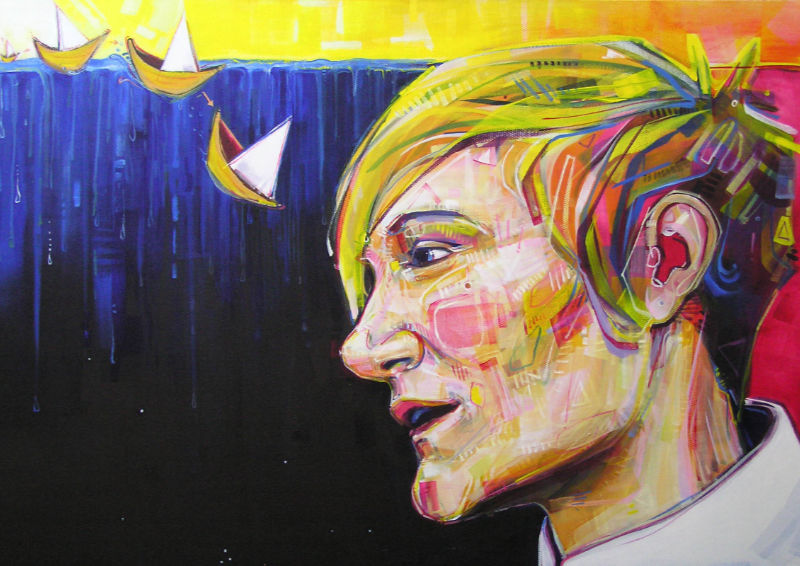
Before: She Can Call Herself a Woman
2006
acrylic on bird’s eye piqué
34 x 48 inches
(Part of a series of “before” and “after” portraits.)
I’ve known since middle school that some people sexualize kindness—and by “some people” I mean mostly cis boys and men. For these people, there’s a fine line between being nice and being flirtatious, and, if they think you’ve crossed that line, they’re certain that you’re hitting on them.
Kindness-sexualizers make it very difficult for the rest of us—primarily cis or trans women as well as genderfree people who look feminine—to maintain professional relationships without being accused of being a tease.
This is can be dangerous. Those who sexualize kindness can easily go from assuming someone is flirting to acting on their assumptions. Best case scenario: they end up sabotaging you like The Critic did me. Worst case: they sexually assault you.
More often than not though, figuring out how to navigate certain cis men is just exhausting. Professional etiquette requires a degree of niceties between people working together, but how much will be seen as flirtatious by kindness-sexualizers? How little will get you labeled a “bitch”? Impossible to know, since each one of them has his own standard for what’s both nice enough and also not too nice.
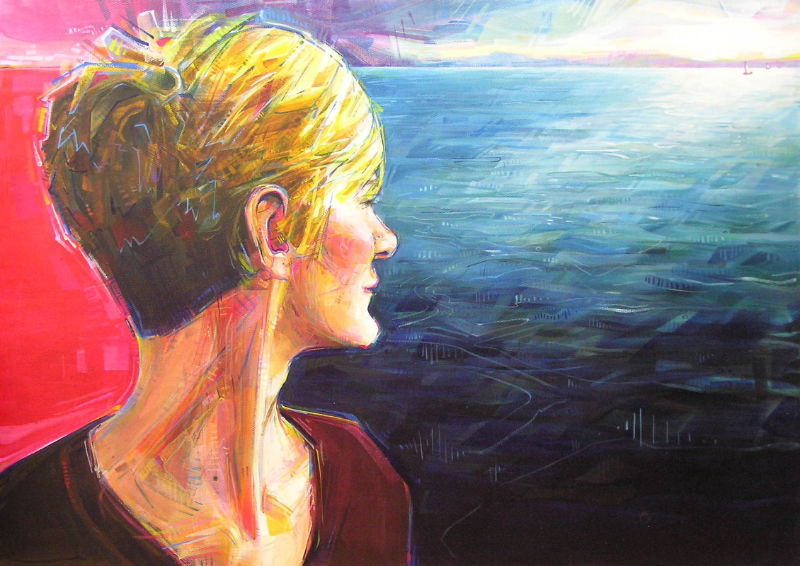
After: She Can Call Herself a Woman
2007
acrylic on bird’s eye piqué
34 x 48 inches
(Part of a series of “before” and “after” portraits.)
Now and again, I still make the same mistake I made with The Critic. I blame myself when certain people see my kindness as flirtation.
In fact, I just did it again a few months ago. Intellectually, I know that nothing short of me being cold with this person would have allowed me to avoid the situation I’m currently in. Nevertheless, there’s a part of me that wants to believe I could have been as warm as I was while also making it completely clear that my only interest was friendship.
This kindness-sexualizer—the same misogynistic buttface who’s going around town badmouthing me, as described in this post—needs to be told that he has to take responsibility for himself and the stalker-ish behavior he engaged in before deciding he’d rather try to ruin my reputation. And maybe one day I’ll find the courage to do just that, but, for the moment, I’ve been ignoring him whenever we cross paths.
I hate the patriarchy and all the ways it tricks me into thinking I’m to blame for anything distressing in my life. Maybe in another couple of decades I’ll have fully internalized the novel concept that I can be kind without being a problem. In the meantime, there’s no way I’m going to let it stop me from painting.
* The quote in this sentence is taken directly from The Critic’s review, which you can read in its entirety here.
There will soon be twenty mistakes published to celebrate my twenty years, but, for now, you can read about these:
- Putting off making changes.
- Publishing art that’s not my best.
- Trying to be like everyone else.
- Worrying about being too sensitive.
- Blaming myself for being too nice.
- Confusing bravery with confidence.
- Not realizing that people want me to succeed.
- Hiding my queer identity for years.
- Feeling guilty about wanting to earn money with my art.
- Not asking for help enough.
- People pleasing.
- Being afraid of feedback.
- Not listening enough.
- Believing in the big break.
- Thinking my positivity would make my art better.
- Getting on social media in the first place.
- Expecting my creativity to be linear.
- Worrying about cheating in art.
Maybe this post made you think of something you want to share with me? Or perhaps you have a question about my art? I’d love to hear from you!
To receive an email every time I publish a new article or video, sign up for my special mailing list.
If you enjoyed this post, Ko-fi allows you to donate. Every dollar you give is worth a bajillion to me!



